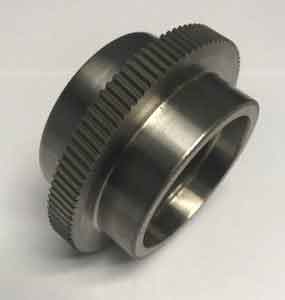 Powdered metal gears are made through the process of powder metallurgy. There have been many advances to this process over the years, which have in turn caused an increase in the popularity of powdered metal as a gear material.
Powdered metal gears are made through the process of powder metallurgy. There have been many advances to this process over the years, which have in turn caused an increase in the popularity of powdered metal as a gear material.
Powdered metal gears are used in many industries, but are used most in the automotive sector. Typical automotive applications include engine parts such as sprockets and pulleys, gear shift components, oil pump gears, and turbocharger systems. Powder metallurgy can be used to produce spur gears, helical gears, and bevel gears.
What is Powder Metallurgy?
Powder metallurgy is a process for forming metal parts. There are three steps in the process:
- Mixing the metal powders
- Compacting the powders to the desired shape
- Heating the compacted shape under controlled conditions
The end result is a metal part that is nearly identical to the desired shape and requires little or no machine finishing, depending on the level of precision needed.
Advantages and Disadvantages of Powdered Metal Gears
The primary reason that powdered metal gears may be preferred over more traditional gear materials is cost. In large production quantities, it is less expensive to manufacture a gear made of powdered metal than a gear made of iron or steel. First, less energy is used during manufacture, and there is also very little material waste. The manufacturing cost is also generally less when considering that many powdered metal parts do not require very much, if any, machine finishing.
Other features that make powdered metal appealing have to do with its material structure. Due to the porous composition of powdered metal gears, they are lightweight and typically run quietly. Also, the powder material can be uniquely mixed, producing unique characteristics. For gears, this includes the opportunity to impregnate the porous material with oil, resulting in gears that are self-lubricated.
There are some drawbacks to powdered metal gears, however. One of the most significant is that powdered metal is not as strong, and also wears more quickly than other materials. There are also size limitations when using powdered metal materials to maintain both manufacturability and effectiveness of the gear. It is also generally not cost efficient to produce powdered metal gears in low to medium sized production quantities.
Machine Finishing on Powdered Metal Gears
We already stated that there is a lessened need for machine finishing on powdered metal parts. But there are cases, of course, where additional machining is necessary on a powdered metal gear. For example, some gears used in critical applications require a high level of precision that the powder metallurgy process cannot achieve.
As a precision gear manufacturer, China Gear Motions is capable of performing several finishing operations on powdered metal gears. This includes precision gear grinding on spur and helical gears. Finishing techniques such as precision gear grinding produce accurate tooth profiles and a quality surface finish.
We can also perform gear cutting operations to cut gear teeth on powdered metal blanks. This operation is particularly useful when producing helical gears, as angled teeth can be difficult to form using powder metallurgy.
With advanced manufacturing machinery and a skilled work force, China Gear Motions is well equipped to handle all of your gear manufacturing needs. Contact us with questions or to get a quote today.
Sources:
- Machine Design: Powder metallurgy gears gain strength and viability
- Powder Metallurgy Review: Powder Metallurgy: The process and its applications






